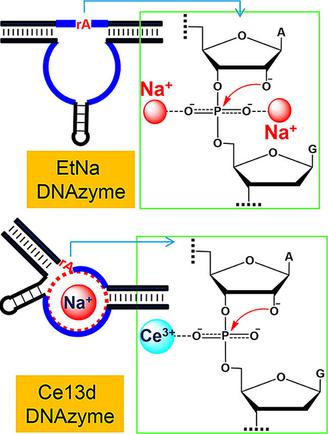当前位置:
X-MOL 学术
›
ChemBioChem
›
论文详情
Our official English website, www.x-mol.net, welcomes your
feedback! (Note: you will need to create a separate account there.)
Two Completely Different Mechanisms for Highly Specific Na+ Recognition by DNAzymes
ChemBioChem ( IF 2.6 ) Pub Date : 2017-08-03 06:31:59 , DOI: 10.1002/cbic.201700184 Wenhu Zhou 1, 2 , Runjhun Saran 1 , Jinsong Ding 2 , Juewen Liu 1
ChemBioChem ( IF 2.6 ) Pub Date : 2017-08-03 06:31:59 , DOI: 10.1002/cbic.201700184 Wenhu Zhou 1, 2 , Runjhun Saran 1 , Jinsong Ding 2 , Juewen Liu 1
Affiliation

|
Our view of the interaction between Na+ and nucleic acids was changed by a few recently discovered Na+-specific RNA-cleaving DNAzymes. In addition to nonspecific electrostatic interactions, highly specific recognition is also possible. Herein, two such DNAzymes, named EtNa and Ce13d, are compared to elucidate their mechanisms of Na+ binding. Mutation studies indicate that they have different sequence requirements. Phosphorothioate (PS) substitution at the scissile phosphate drops the activity of EtNa 140-fold, and it cannot be rescued by thiophilic Cd2+ or Mn2+, whereas the activity of PS-modified Ce13d can be rescued. Na+-dependent activity assays indicate that two Na+ ions bind cooperatively in EtNa, and each Na+ likely interacts with a nonbridging oxygen atom in the scissile phosphate, whereas Ce13d binds only one Na+ ion in a well-defined Na+ aptamer, and this Na+ ion does not directly interact with the scissile phosphate. Both DNAzymes display a normal pH–rate profile, with a single deprotonation reaction required for catalysis. For EtNa, Na+ fails to protect the conserved nucleotides from dimethyl sulfate attack, and no specific Na+ binding is detected by 2-aminopurine fluorescence, both of which are different from those observed for Ce13d. This work suggests that EtNa binds Na+ mainly through its scissile phosphate without significant involvement of the nucleotides in the enzyme strand, whereas Ce13d has a well-defined aptamer for Na+ binding. Therefore, DNA has at least two distinct ways to achieve highly selective Na+ binding.
中文翻译:

DNA酶高度特异性Na +识别的两种完全不同的机制
我们对Na +与核酸之间相互作用的看法被一些最近发现的Na +特异性RNA裂解DNA酶改变了。除了非特异性静电相互作用之外,高度特异性的识别也是可能的。在此,比较了两个这样的DNA酶,即EtNa和Ce13d,以阐明其Na +结合的机理。突变研究表明它们具有不同的序列要求。易裂磷酸盐处的硫代磷酸酯(PS)取代使EtNa的活性降低140倍,并且不能被亲硫的Cd 2+或Mn 2+挽救,而PS修饰的Ce13d的活性却可以挽救。依赖于Na +的活性测定表明,有两个Na +离子在EtNa中协同结合,每个Na +可能与易裂磷酸中的非桥接氧原子相互作用,而Ce13d在明确定义的Na +适体中仅结合一个Na +离子,并且该Na +离子不直接与Na +适体相互作用。易裂磷酸盐。两种脱氧核糖核酸酶均显示正常的pH速率分布,并且催化需要单个去质子化反应。对于EtNa,Na +无法保护保守的核苷酸免受硫酸二甲酯的攻击,并且2-氨基嘌呤荧光未检测到特定的Na +结合,两者均与Ce13d观察到的不同。这项工作表明EtNa可以结合Na +主要通过其易裂的磷酸盐,而没有明显参与酶链中的核苷酸,而Ce13d对Na +结合具有明确的适体。因此,DNA具有至少两种截然不同的方式来实现高度选择性的Na +结合。
更新日期:2017-08-03
中文翻译:

DNA酶高度特异性Na +识别的两种完全不同的机制
我们对Na +与核酸之间相互作用的看法被一些最近发现的Na +特异性RNA裂解DNA酶改变了。除了非特异性静电相互作用之外,高度特异性的识别也是可能的。在此,比较了两个这样的DNA酶,即EtNa和Ce13d,以阐明其Na +结合的机理。突变研究表明它们具有不同的序列要求。易裂磷酸盐处的硫代磷酸酯(PS)取代使EtNa的活性降低140倍,并且不能被亲硫的Cd 2+或Mn 2+挽救,而PS修饰的Ce13d的活性却可以挽救。依赖于Na +的活性测定表明,有两个Na +离子在EtNa中协同结合,每个Na +可能与易裂磷酸中的非桥接氧原子相互作用,而Ce13d在明确定义的Na +适体中仅结合一个Na +离子,并且该Na +离子不直接与Na +适体相互作用。易裂磷酸盐。两种脱氧核糖核酸酶均显示正常的pH速率分布,并且催化需要单个去质子化反应。对于EtNa,Na +无法保护保守的核苷酸免受硫酸二甲酯的攻击,并且2-氨基嘌呤荧光未检测到特定的Na +结合,两者均与Ce13d观察到的不同。这项工作表明EtNa可以结合Na +主要通过其易裂的磷酸盐,而没有明显参与酶链中的核苷酸,而Ce13d对Na +结合具有明确的适体。因此,DNA具有至少两种截然不同的方式来实现高度选择性的Na +结合。











































 京公网安备 11010802027423号
京公网安备 11010802027423号